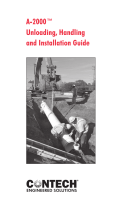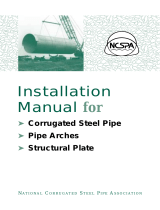Page is loading ...

P309-0042
Rev. L
© Copyright 2012 Hubbell Incorporated Printed in U.S.A.
EARTH PROBE
CARE AND OPERATING INSTRUCTIONS
NOTE: Hubbell has a policy of continuous product improvement. We
reserve the right to change design and specications without notice.
Class 1 soils are difficult to probe consistently and the ASTM blow count may be of questionable value.
*In areas only seasonally wet with slow drain as in fairly flat terrain.
SOIL CLASSIFICATION DATA
Typical
Blow Count
“N” per
ASTM-D1586
N.A.
60-100+
45-60
35-50
24-40
14-25
7-14
4-8
0-5
Class
0
1
2
3
4
5
6*
7
8
Common Soil-Type Description
Sound hard rock, unweathered (bedrock)
Very dense and/or cemented sands;
coarse gravel and cobbles
Dense fine sands; very hard silts
and clays (may be preloaded)
Dense sands and gravel;
hard silts and clays
Medium dense sand and gravel; very
stiff to hard silts and clays
Medium dense coarse sands and sandy
gravels; stiff to very stiff silts and clays
Loose to medium dense fine to coarse
sands to stiff clays and silts
Loose fine sands; Alluvium; loess;
medium - stiff and varied clays; fill
Peat, organic silts; inundated silts, fly ash
very loose sands, very soft to soft clays
Probe Values
ft-lbs.
in.-lbs.
(NM)
N.A.
63 - 39
750 - 1600
(85-181)
50 - 63
600 - 750
(68-85)
42 - 50
500 - 600
(56 - 68)
33 - 42
400 - 500
(45 - 56)
25 - 33
300 - 400
(34 - 45)
17 - 25
200 - 300
(23 - 34)
8 - 17
100 - 200
(11 - 23)
<8
<100
(0 - 11)
Geological Soil Classification
Granite, Basalt, Massive Limestone
Caliche, (Nitrate-bearing gravel/rock)
Basal till; boulder clay; caliche;
weathered laminated rock
Glacial till; weathered shales, schist,
gneiss and siltstone
Glacial till; hardpan; marls
Saprolites, residual soils
Dense hydraulic fill;
compacted fill; residual soils
Flood plain soils; lake clays;
adobe; gumbo, fill
Miscellaneous fill, swamp marsh
1. To drive, rotate probe clockwise with ratchet wrench while applying moderate down pressure.
2. Drive to desired depth as indicated by 1 ft. interval marks on corners of shaft by applying a smooth, rotational force.
3. To read, support probe shaft with one hand while rotating probe steadily with torque wrench. Read with probe rotating.
4. Do not exceed capacity of torque wrench (1800 in-lbs).
5. Attach extension sections, as needed, being sure that spring locking device snaps into hole in extension section. (Failure to observe
this precaution may result in loss of one or more probe sections in the ground.)
6. Use soil classification data chart to interpret probe readings.
7. Before storing, wipe clean and dry. If wrench has been in water or mud, disassemble the ratchet wrench to clean, dry and oil the
mechanism.
BILL OF MATERIAL
(1800 in-lb Capacity)
C309-0032 20' Probe Complete
C309-0033 Extra 5' Extension
E309-0038P Screw & Shaft Assembly
P309-0039P Ratchet Wrench
P309-0040P Torque Wrench
E309-0041P Carrying Case 20'
/




